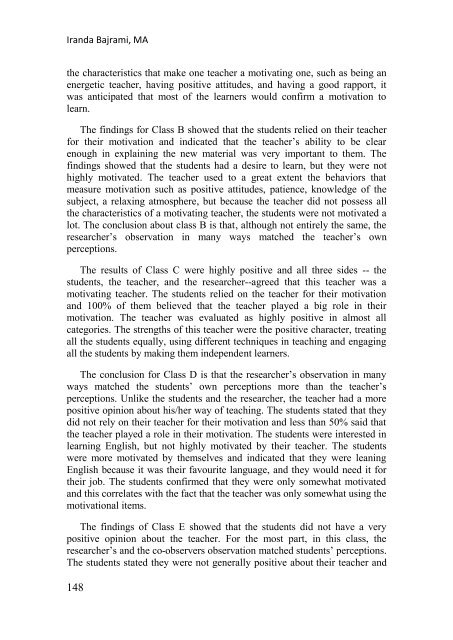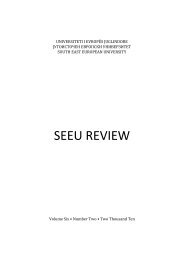SEEU Review vol. 5 Nr. 2 (pdf) - South East European University
SEEU Review vol. 5 Nr. 2 (pdf) - South East European University
SEEU Review vol. 5 Nr. 2 (pdf) - South East European University
Create successful ePaper yourself
Turn your PDF publications into a flip-book with our unique Google optimized e-Paper software.
Iranda Bajrami, MA<br />
the characteristics that make one teacher a motivating one, such as being an<br />
energetic teacher, having positive attitudes, and having a good rapport, it<br />
was anticipated that most of the learners would confirm a motivation to<br />
learn.<br />
The findings for Class B showed that the students relied on their teacher<br />
for their motivation and indicated that the teacher’s ability to be clear<br />
enough in explaining the new material was very important to them. The<br />
findings showed that the students had a desire to learn, but they were not<br />
highly motivated. The teacher used to a great extent the behaviors that<br />
measure motivation such as positive attitudes, patience, knowledge of the<br />
subject, a relaxing atmosphere, but because the teacher did not possess all<br />
the characteristics of a motivating teacher, the students were not motivated a<br />
lot. The conclusion about class B is that, although not entirely the same, the<br />
researcher’s observation in many ways matched the teacher’s own<br />
perceptions.<br />
The results of Class C were highly positive and all three sides -- the<br />
students, the teacher, and the researcher--agreed that this teacher was a<br />
motivating teacher. The students relied on the teacher for their motivation<br />
and 100% of them believed that the teacher played a big role in their<br />
motivation. The teacher was evaluated as highly positive in almost all<br />
categories. The strengths of this teacher were the positive character, treating<br />
all the students equally, using different techniques in teaching and engaging<br />
all the students by making them independent learners.<br />
The conclusion for Class D is that the researcher’s observation in many<br />
ways matched the students’ own perceptions more than the teacher’s<br />
perceptions. Unlike the students and the researcher, the teacher had a more<br />
positive opinion about his/her way of teaching. The students stated that they<br />
did not rely on their teacher for their motivation and less than 50% said that<br />
the teacher played a role in their motivation. The students were interested in<br />
learning English, but not highly motivated by their teacher. The students<br />
were more motivated by themselves and indicated that they were leaning<br />
English because it was their favourite language, and they would need it for<br />
their job. The students confirmed that they were only somewhat motivated<br />
and this correlates with the fact that the teacher was only somewhat using the<br />
motivational items.<br />
The findings of Class E showed that the students did not have a very<br />
positive opinion about the teacher. For the most part, in this class, the<br />
researcher’s and the co-observers observation matched students’ perceptions.<br />
The students stated they were not generally positive about their teacher and<br />
148

















